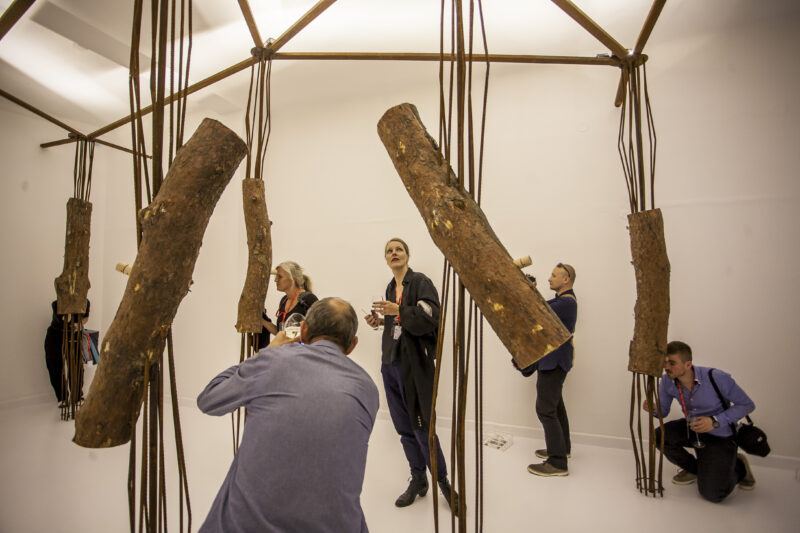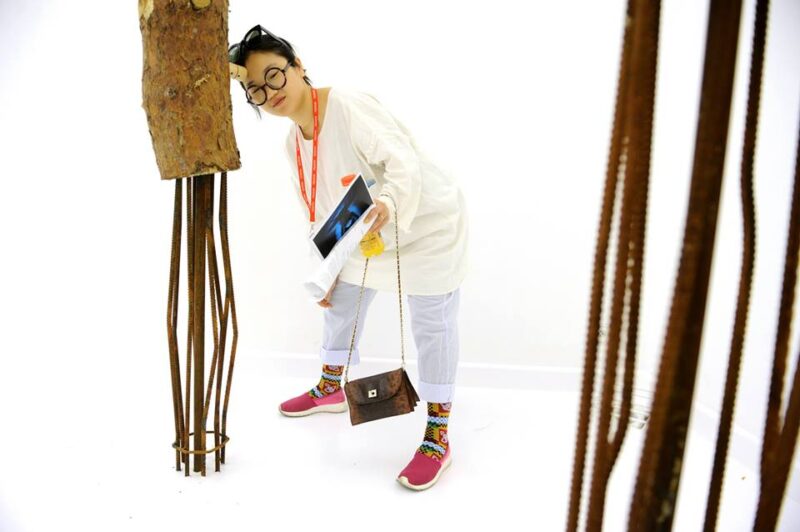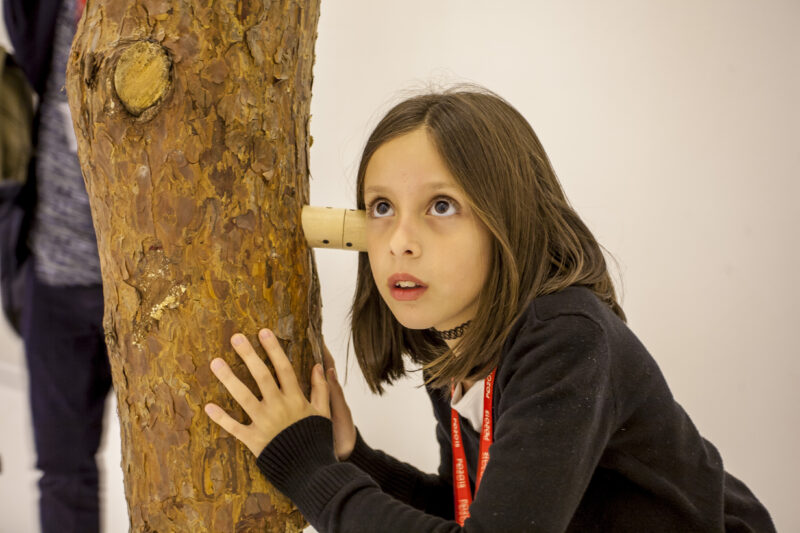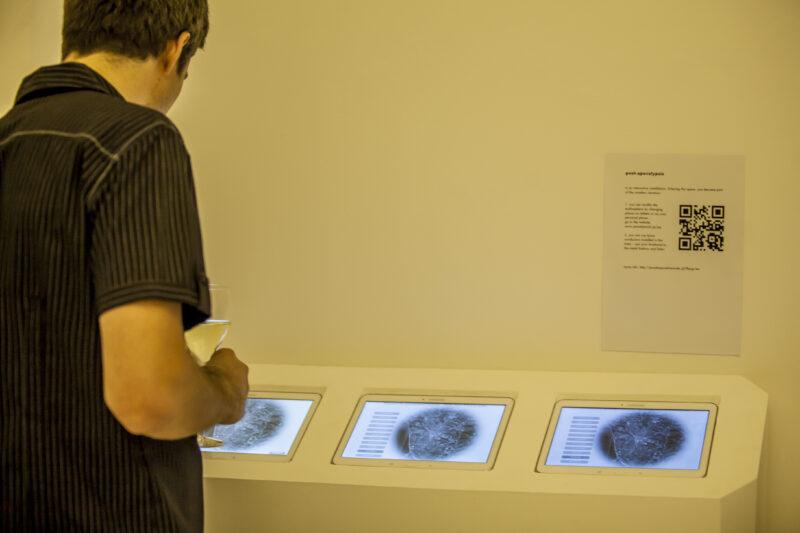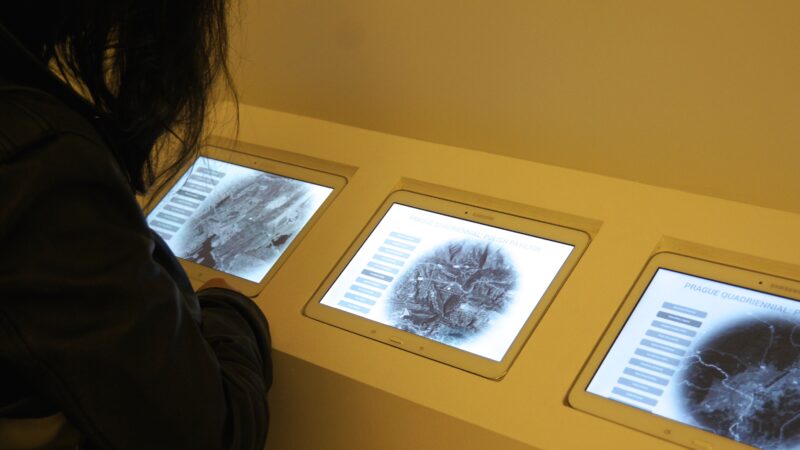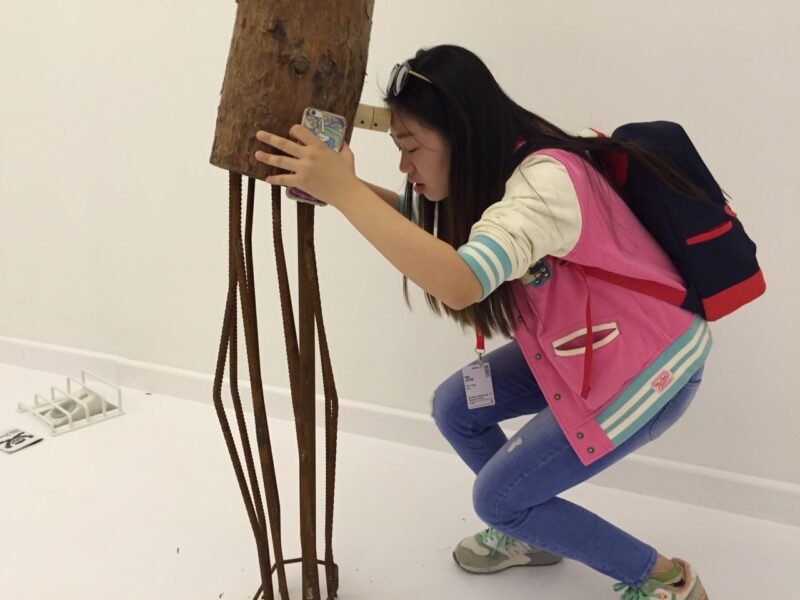Post-Apocalypsis
The Polish national exhibition Post-Apocalypsis has been awarded the Gold Medal of the 13th Prague Quadrennial of Performance Design and Space festival. // 18-28.06.2015, Prague, Czech Republic
Post-Apocalypsis // Curator’s introduction on National Exhibition
Agnieszka Jelewska
Nowadays, weather can’t be defined solely as a condition of the atmosphere, external to man, as it takes place on planetary, networked and techno-natural scales, of which the human being is an immanent element. The very condition does not pertain solely to geological, biospheric transformations undertaken by us within the whole ecosystem, but also to their economic, political, social and cultural consequences. Weather conditions in today’s world are a concurrence of all those factors that impact the states of anxiety, threat and constant crisis. The Post-Apocalypsisinstallation is an attempt to indicate complicated assemblages created by contemporary men with techno-nature, which does not actually surround them but co-shapes the contemporary space with them for the survival of life on Earth. From the perspective of that project, weather is an audio-somatic aura, shaped by endless performance, taking place between human and nonhuman actors.
In 1968, when Jerzy Grotowski was preparing his last performance of Apocalypsiscum figuris, one of the most important theatre works of the 20th century, he was thinking about space as a value that plays out and extends solely among people. It was an empty, anthropocentric space, open both to establishing relations and to quests for individual spiritual depth. The gesture to recall that event made by us today, at the beginning of the 21st century, has an extraordinary meaning – in particular if one of the provocateurs of that act is Jerzy Gurawski, the stage designer who cooperated with the director in the initial phase of the latter’s artistic activity. Moreover, ideas of romanticism are returning very clearly nowadays, demanding to be read anew, but not solely from national-liberation or purely human-spiritual perspectives, but in a manner that more explicitly unveils the thinking of systemic, global, dispersed and relational life on Earth.
For Grotowski, apocalypse stood in a sense for decomposition and defragmentation of the tradition of romanticism – crucial at that time for Polish history – and also of more broadly understood dramatic text, dialogue or stage communication. At the same time, it was a barometer of change and revaluation happening in the culture of the West, including the transcending of classical theatrical situations of re-acting and freeing its deep performative potential but also, as a consequence, introducing this potential into social, political and economic dimensions. Intellectual movements of the 1960s were coupled with significant turning points in both the discursive stratum and in socio-political practices. One of these was the current deconstructing the domination of a single stable vision of the human being that was entering new, difficult and complicated times of relativism, performativity and openness towards nomadic, supranational choices, concerning not only the place of dwelling but also the model of existence. Around that time, Marshal McLuhan announced his concept of the global village, plugging an open, dynamic subject somehow into the framework of the networked communication system based on data flow and electronic circuits.
The political and economic situation of Poland was totally different back then. Despite the fact that the transformation from the 1950s to the 1960s was the time of the so-called Thaw in politics and culture after Stalin’s death – when the idea of artistic laboratories was born, where one could experiment with new forms of art and paradigms of its cognition (as was done by Grotowski, for instance), with cybernetics and new research entering science – the year 1968 also marked a period of great intensity, with waves of oppression by the authorities, this time targeting mostly students. The socio-cultural crisis that ensued became a strong sign of continuation in the era of Cold War censorship and discipline, encompassing not only the development of intellectual thought but also the whole sphere of biopolitics. Poland, naturally, closed itself up in the hard local perspective of a large-scale geopolitical conflict. In fact, it was the later breakthrough of 1989 that sparked the development of new cultural, social and political practices. In the same period, direct incorporation into the global economic and communication system generated another wave of anxiety – this time with a network- and system-wide dimension.
As we can observe it now, the geopolitical situation still has an active character, and the borders of contemporary Europe, which after a long, very painful breakup of the so-called Eastern Bloc were stabilized – or so it might seem – are still undergoing territorial shifts nowadays. A new situation of political and emotional agitations is created, which intensifies the condition of global weather. Therefore Poland, as well as other countries – not only European ones – currently finds itself in the sphere of the real reach of mobile geopolitical changes, which fuel social unrests powerfully and at the same time evoke romantic emotions. Global circulation of low- and high-pressure fronts understood in such a manner creates variable parameters bridging a contemporary human being between a local condition of networking, allowing for drift, and a struggle to keep or expand the territory, which today is usually connected with access to the extraction of natural resources.
The Post-Apocalypsis installation projects a precise contemporary vision of the networked and global world. Viewers enter directly into a condensed space of real-time weather-data streams, including those from places of energy-related threats and disasters on Earth (Chernobyl, Los Alamos, Fukushima). The constantly updated data is processed artistically through sonification – in this way, the installation is filled with a changing audiosphere, active towards human presences. Energetic communicational switches can be experienced also within the framework of surprising, designed interaction with technologically transformed elements of nature. Any previous romantic visions of nature, presented as a landscape and background for human events – once so crucial for the development of theatre stage design – are radically revised.
At the same time, the very romanticism that is particularly meaningful as a project of the Polish national-liberation tradition, opens in the Post-Apocalypsis installation towards ecological parameters of cognition. We tend to forget that romanticism introduced nature into the space of a performative event. The concept of nature as a scenography for romantic dramas emphasized the practice of theatre and the role of performance as one of the first technological laboratories of arrangement, management and direct impact on social conditions. As Bruno Latour writes, “Westerners were the ones who turned nature into a big deal, an immense political diorama, formidable moral gigantomachy, and who constantly brought nature into the definition of their social order” Bruno Latour, Politics of Nature: How to Bring theSciences into Democracy, translated by Catherine Porter, Harvard University Press, Cambridge, MA, 2004, p. 43.. Theatre experiments, once limited solely to theatre space, were then extended onto the totality of social activities, revealing a broader, more transdisciplinary understanding of design as complicated, often camouflaged processes of the engineering of nature-societies.
In the interaction that the exhibition assumes, a new understanding of technology is also revealed. Commonly defined in the romantic approach as an antinomy to nature, it becomes a part of nature in the installation, forming with it and the viewers a hybrid communication ecosystem. In Post-Apocaplypsis, we are faced with man treated primarily as an active part of earthly weather. By means of technological tools, man is able to impact many factors determining the conditions of existence and survival of organisms on Earth. Complicated systems of data recording and translation constitute manners of cognition and, perhaps, an approximation of some phenomena of life – yet, at the same time, various forms of existence and processes of nature strongly determine qualities and manners of cognition. Contemporary man is therefore an actor acting in the perspective of earthly responsibility, and becomes a part of energy-biological-geological processes. A sign of this is his presence, cognitive decisions, ways of moving and interaction during the exhibition, which impact and alter the entire atmosphere of the installation. As in the real global experience of a dynamic weather condition, which must today be understood as a concurrence of “natural” phenomena and of social, political and economic anxiety. This is why the performance of “life” takes place ceaselessly in technologically mediated global systems, tying together the human and the nonhuman in the situation of an apocalypse that is in fact an immanent premonition of the contemporary. Weather conditions experienced in such a way intertwine atmospheric data with political processes, and natural disasters with wars.
Ecosystem of Post-Apocalypsis
Michał Krawczak
The concept of the Post-Apocalypsis installation does not only fulfil the principle of transdisciplinary creative process, but also constitutes a resultant of ecosystemic thinking about the relations between the human being, nature and technology. Work on the installation was based on team design, where each of the participants, bringing in his or her artistic competences or knowledge, was at the same time ready to negotiate common ground. In such a manner, a unique interactive space was created which denies the idea of hierarchisation of the media, structures or an executive act that used to characterise theatre in its classical understanding. Such a heterarchical process, based on networks and horizontal relations, becomes a new performative, dialogic and open paradigm of creation. It is crucial from the perspective of the idea that stands behind the installation. Co-creation of space by various artists, engineers and researchers embodies what the exhibition wishes to induce the spectator towards: a deep reflection on his or her spatial, somatic and sensory relation towards technologically mediated nature.
The audiosphere of Post-Apocalypsis that surrounds the viewers is woven from real-time weather data from selected points on Earth that constitute important places of human intervention, which significantly impact climatic and geological changes. Spectators, immersed in the weather of sonified data, are directly incorporated into the biotechnological ecosystem. Therefore, the space of the installation undergoes territorial dispersion and makes spectators experience the effect of perceptual extension. Elements of nature introduced into the installation – technologized trees – communicate through interfaces of bone conduction, romantic and political confessions carrying a local, national and identity potential, which fall apart as a result of transmission disturbances. Errors and electronic glitches in the act of communication between spectator and techno-natural surroundings harmonize with dynamic atmospheric states, creating an impression of an elevated level of threat.
Post-Apocalypsis is thus an attempt to tackle new definitions of space that the contemporary human being, immersed in ecosystem narratives, faces. In this case, designing of space does not have the character of creating a separate place where definitions of locality, nationality and identity are meaningful, but rather an unstable sphere, susceptible to changes induced by external as well as centrifugal social, political or technological stimuli.
Team
Curator: Agnieszka Jelewska
Space designer: Jerzy Gurawski & ARPA Studio
Experience designer: Michał Krawczak
Sound designer: Rafał Zapała
Interaction designer: Paweł Janicki
Interactive system engineer: Michał Cichy
Producer: Anna Galas-Kosil
Coordinator: Edyta Zielnik
